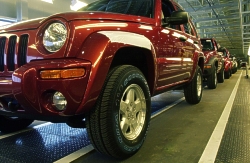
.
. .
..
. . .
MY 2005 Jeeps MY 2001 Jeeps Jeep Concepts
© 1999-2006 Copyright |
DaimlerChrysler Corporation’s New Toledo North Assembly Plant Represents Worldwide Best Practices for Lean, Flexible, High-Quality Manufacturing Part 2: Best practice manufacturing ...........back to part 1 Part of the benchmarking with the Mercedes-Benz plants yielded several best practices and manufacturing synergies that can be seen in the new plant, such as skillet and "gummiband" conveyors, a proprietary sealer system and a door weather stripping operation.
Not only does this free the space to assemble multiple models, more importantly, this kind of conveyor is more ergonomically sound for operators. Each palette can be customized for each product, station and operation.
The proprietary sealer system, referred to at TNAP as the "Sindelfingen Sealer System," named after the Mercedes-Benz plant just outside of Stuttgart where it came from, is an operation that applies sealer to the vehicle’s body before it is painted.
Virtual Manufacturing Makes Toledo North an Industry Benchmark The entire Toledo North plant and tooling was designed using manufacturing simulation software, which enabled the company to build the facility for only $54 per square foot - an industry benchmark (compared to an industry average of $70 - $80 per sq. ft.). "By simulating manufacturing we can make tooling and equipment updates in a virtual environment rather than with the actual tooling, which is a phenomenal savings of cost and manpower throughout the supply chain," said Frank Ewasyshyn, Senior Vice President, Advanced Manufacturing Engineering and General Manager, Minivan Operations, DaimlerChrysler. "Simulation allows the tooling process within the manufacturing facility to be much more precise, resulting in assembly operations being brought up to speed faster with fewer issues." With this application, the company can create a seamless union between product development and manufacturing by using compatible systems to design the vehicles and to simulate build processes in the plant. The vision is to allow the integrated system to cover all aspects of manufacturing, from part design to plant design, helping to get new products to market faster. With this system, DaimlerChrysler was able to simulate the manufacturing environment at TNAP long before any construction began. As the new Jeep Liberty evolved through its development, the manufacturing processes evolved with it, enabling simultaneous engineering to take place. The system uses a single language database across the entire product development and manufacturing process - from product development to plant design. This increases communication, efficiency and supply chain integration. The goal is to use the system to simulate and visualize the entire manufacturing process and plant before any hardware is installed. Flexible Manufacturing for Quick Changeover TNAP follows DaimlerChrysler’s Windsor Assembly Plant as one of the most flexible in the company and in the industry, meaning it has the ability to change and add new products very quickly with minimal disruption or production loss. The key to DaimlerChrysler’s manufacturing flexibility is the order in which the body is put together, using a unique underbody palette system in the body shop. The same flexible palette system has been used at the company’s Sterling Heights Assembly Plant, as well as Windsor and TNAP - meaning the same system can be used to build sedans, convertibles, minivans, and now sport-utility vehicles. While TNAP will begin with only one product, it has the ability to produce another and pilot a third simultaneously. In order to accomplish this, the company first divided the tooling for welding processes into two distinct areas: processes flexible enough to accommodate different vehicles, which are in the aperture, underbody and framing areas; and processes that are specific to an individual vehicle. As the company prepares to build more products there, it will only have to add minimal tooling specific to a new model. The Operating Principles Similar to all of DaimlerChrysler’s manufacturing facilities, TNAP conducts its business using the company’s Operating Principles. Rather than merely a way to assemble vehicles, the Operating Principles represent the way the company does business and maintains its lean Extended Enterprise system. It begins with core values and beliefs, the philosophical principles from which decisions are made. From there, the system analyzes the "how," identifying the enablers and subsystems needed to execute the work (like human infrastructure, balanced schedules, value-added activities and robust processes). It then identifies ways to support those processes, tools for implementation, and standardized measurements to gauge effectiveness. The Operating Principles give employees at the plant the big picture framework from which to operate, at the same time providing standardized methods and repeatable processes. The end result can be tracked and improved by focusing on Safety, Quality, Delivery, Cost and Morale, internal gauges that each employee contributes to. Because continuous improvement is one of the core beliefs, the process never stops. all pictures: Chrysler
|
.
|













